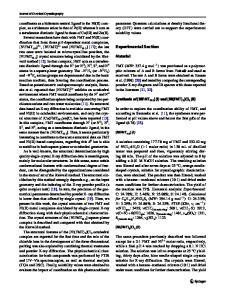Synthesis and crystal structure of new coordination polymers based on sodium aqua complexes and macrocyclic cavitand cuc
- PDF / 1,766,232 Bytes
- 8 Pages / 612 x 792 pts (letter) Page_size
- 33 Downloads / 327 Views
2113
Synthesis and crystal structure of new coordination polymers based on sodium aqua complexes and macrocyclic cavitand cucurbit[6]uril I. V. Andrienko, Е. A. Kovalenko, D. G. Samsonenko, and V. P. Fedin A. V. Nikolaev Institute of Inorganic Chemistry, Siberian Branch of the Russian Academy of Sciences, 3 prosp. Akad. Lavrentieva, 630090 Novosibirsk, Russian Federation. Fax: +7 (383) 330 9489. E-mail: [email protected] The crystals of the compounds [Na4(H2O)14CB[6]](bdc)2•13H2O (1) and [Na6(H2O)19CB[6]](bdc)3•15H2O (2) were obtained by heating an aqueous solution of sodium terephthalate (Na2bdc) and cucurbit[6]uril (CB[6]). According to the single-crystal X-ray diffraction data, the sodium aqua complexes and cucurbit[6]uril molecules form chains (in structure 1) and layered metal-organic frameworks (in structure 2). The structures of the sodium aqua complexes [Na3(H2O)10]3+ in 1 and [Na6(H2O)19]3+ in 2 have been previously unknown. When submitted to ultraviolet radiation, crystals of 1 and 2 exhibit luminescence with an emission maximum at 428 and 434 nm, respectively. Key words: sodium aqua complexes, cucurbit[6]uril, X-ray diffraction, supramolecular chemistry, crystal structure.
Macrocyclic cavitands of the cucurbit[n]uril family have been extensively studied in order to develop new materials for the functionalization of surfaces, the separation of complex mixtures, the design of chemical sensors and biosensors, hydrogels, and proton-conducting materials, and gas adsorption and storage.1—5 One approach to the design of highly ordered cucurbit[n]uril (CB[n])-based supramolecular assemblies relies on the coordination of metal cations with portal oxygen atoms of cavitands.6—8 The binding of metal complexes to CB[n] occurs in two different modes: via the coordination of metal atoms with carbonyl oxygen atoms of CB[n] portals and through hydrogen bonds between aqua ligands of the complex and portal oxygen atoms. The use of cucurbit[6]uril (CB[6]) and its derivatives as polydentate ligands proved to be efficient for the formation of alkali metal complexes in aqueous solutions.9—19 Complexes with molecular, chain, and framework structures are known for these compounds. In some studies, organic and inorganic bridging ligands are additionally utilized.11,15,16,20—22 Organic carboxylates, which can be coordinated to oxophilic metal atoms, are promising bridging ligands. Investigations of the reactions of cucurbiturils with terephthalates made it possible to prepare interesting molecular, chain, and layered structures.16,23—28 Polyoxovanadates, tungstates, and molybdates are examples of inorganic bridges. Chain and framework structures containing cavities were prepared by this approach.12,16,20,21,29,30 In this work, we synthesized and structurally characterized two new coordination polymers with CB[6] of the
formulas [Na 4 (H 2 O) 14 CB[6]](bdc) 2 •13H 2 O (1) and [Na6(H2O)19CB[6]](bdc)3•15H2O (2) (bdc2– is terephthalate). In these compounds, the macrocyclic cavitand cucurbit[6]uril is coordinated to cations of the p
Data Loading...











